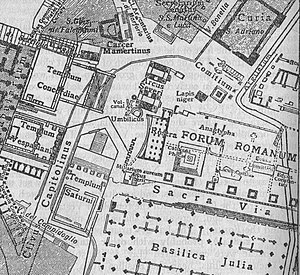Vulcanal
[1] Dedicated to Vulcan, the Roman god of fire, it was traditionally considered to commemorate the spot where the legendary figures Romulus and Tatius concluded the peace treaty between the tribes known as the Latins — on the Palatine Hill — and the Sabines — on the Quirinal and Esquiline.
[4] Other monuments erected here from the earliest times included a statue of Horatius Cocles and another standing on a column and representing an actor who had been struck by lightning during the games in the Circus Maximus.
Behind the excavated foundation of the altar of Vulcan are traces of a flight of steps, cut into the tufa of the Capitoline Hill, which lead up to the vestibule of the Temple of Concord, just to the northwest.
The archaic site had long been reverently preserved when, in 9 AD, the Emperor Augustus refurbished it with a new marble altar (discovered in 1548 and now in the Naples Museum).
Later in the Imperial period, the Vulcanal area suffered by being very much narrowed and partly done away with altogether by building operations associated with the enlargement of the Temple of Concord, the construction of the adjacent Arch of Severus, and other public works.
For example, Richardson's authoritative A New Topographical Dictionary of Ancient Rome, published almost 10 years after Coarelli's work, has this to say: The Vulcanal was distinctly higher than the forum...and Comitium...[T]he kings and magistrates transacted public business there...public assemblies were regularly held there.... [It] was also big enough to include a bronze aedicula.... All this taken together indicates that originally the Vulcanal covered the lower slope of the Capitoline along the stair that extended the line of the Sacra Via up the hill, an area later covered by the Temple of Concordia.

